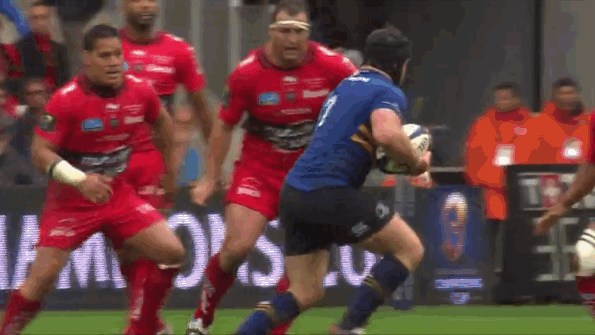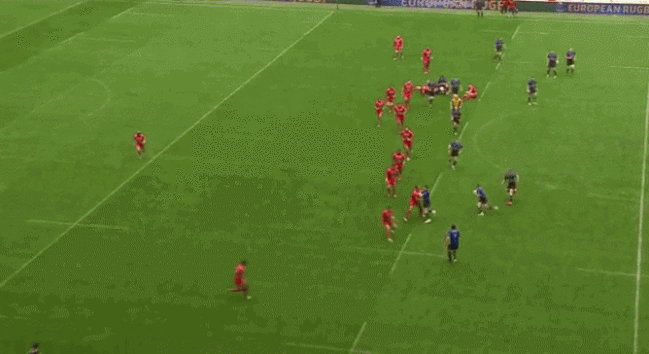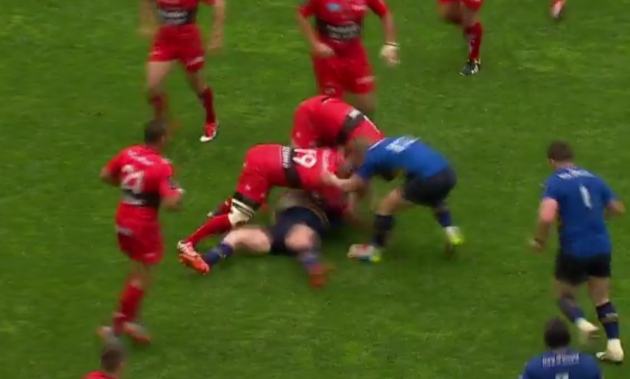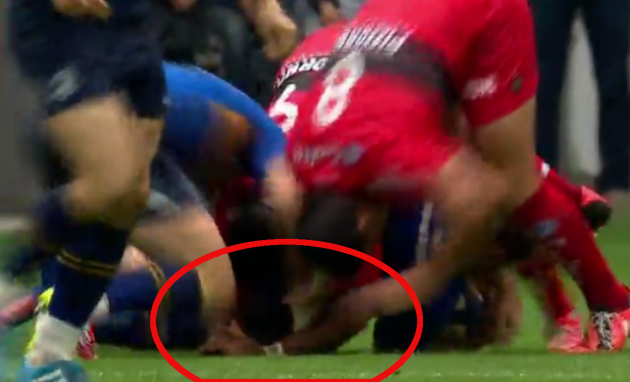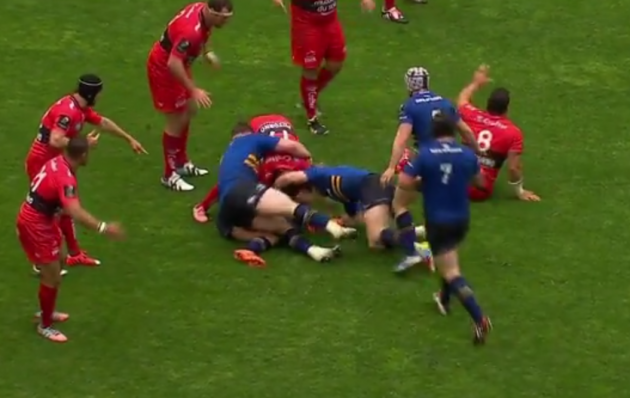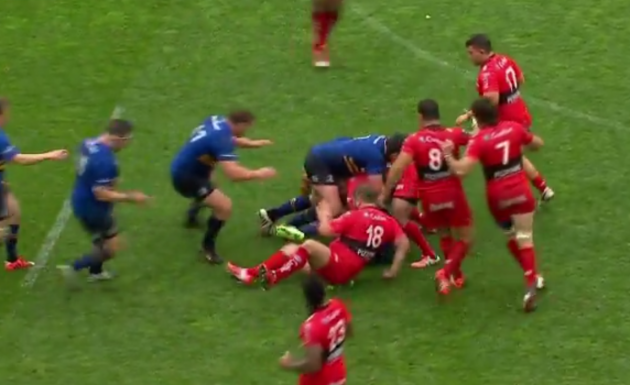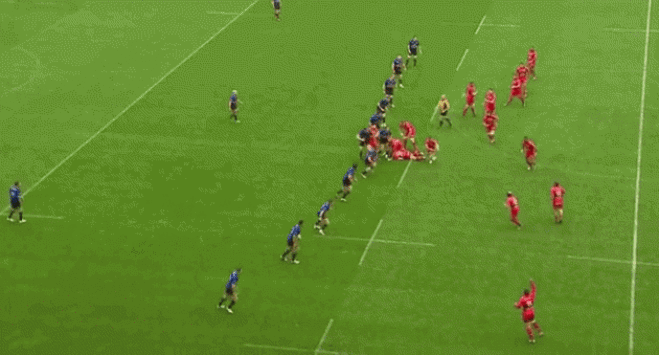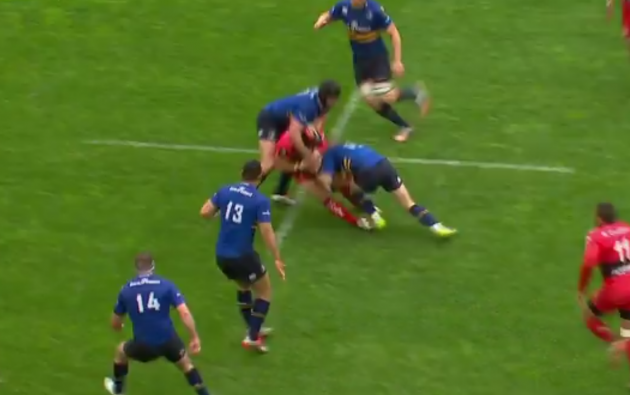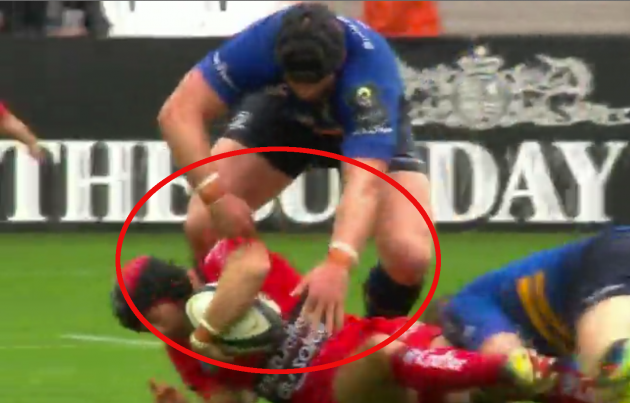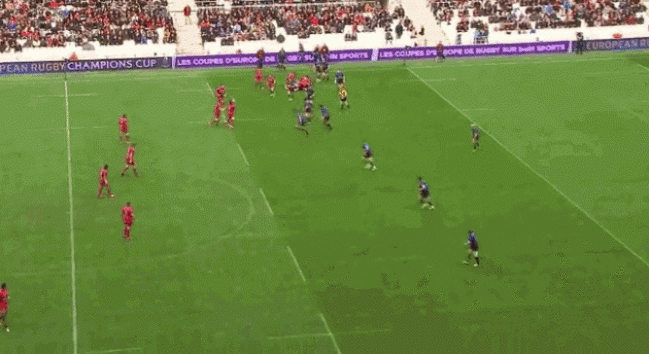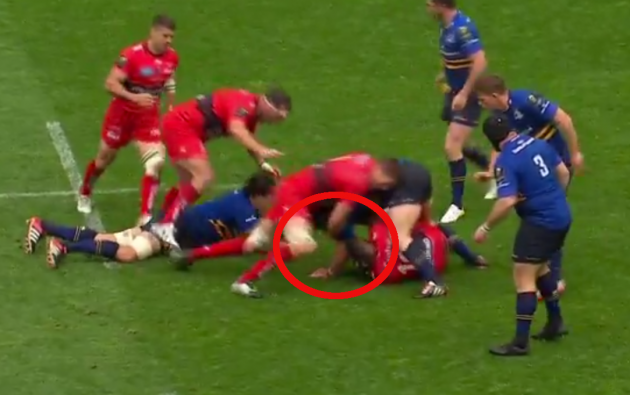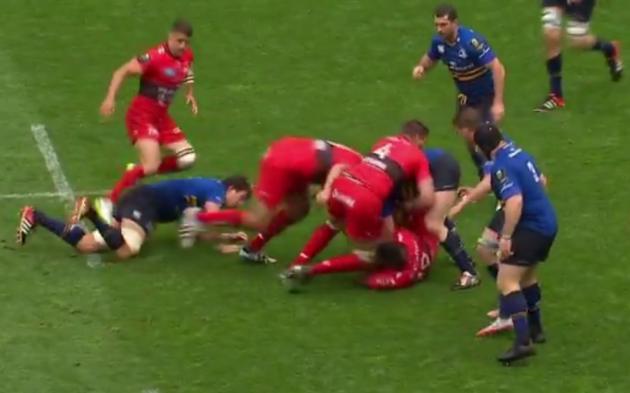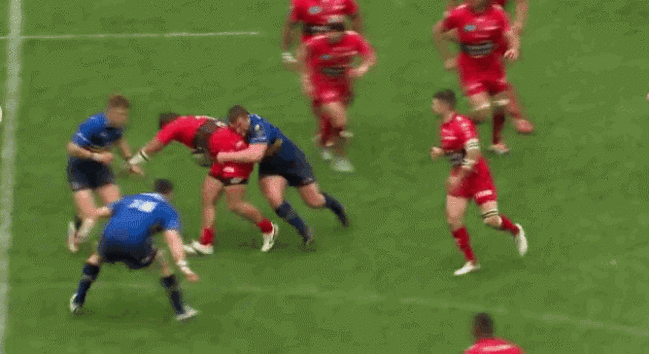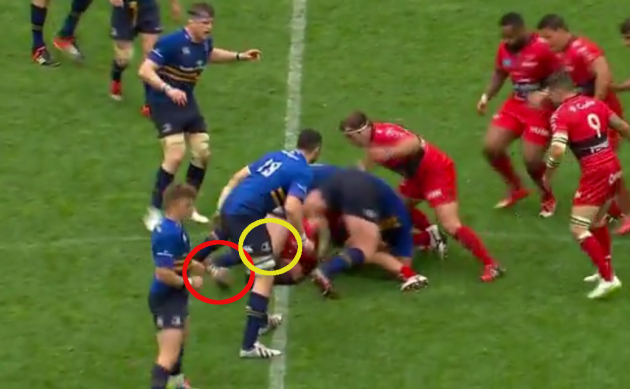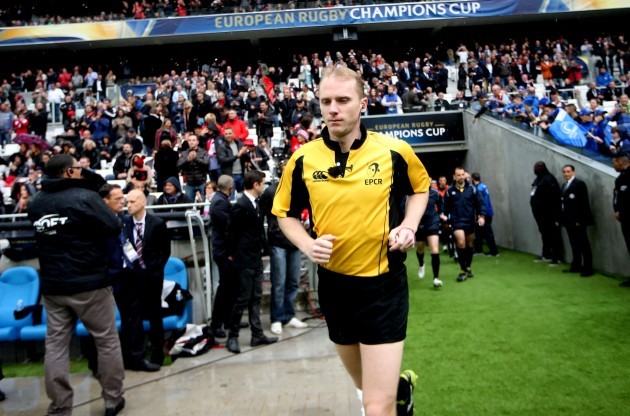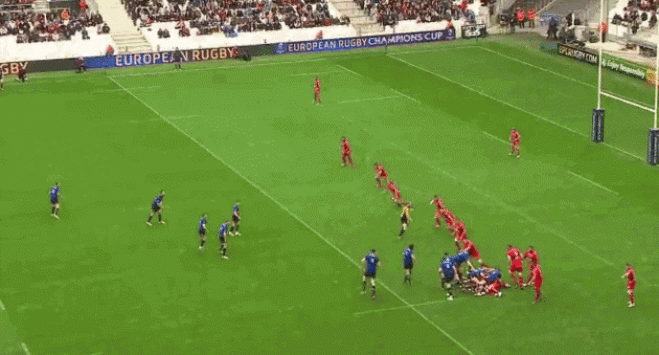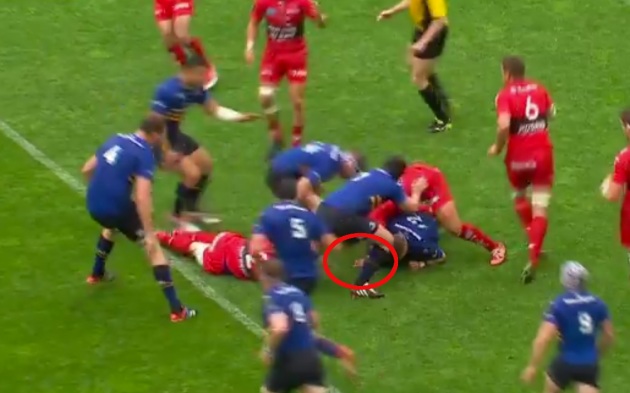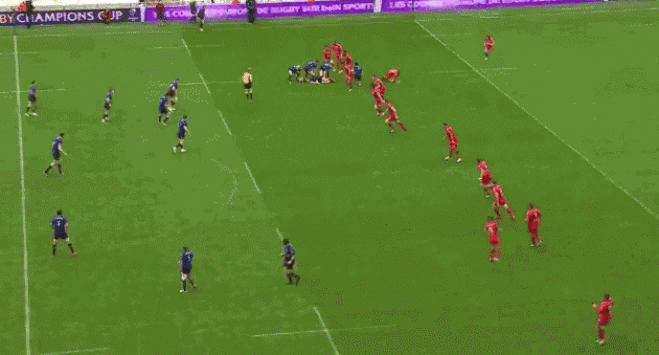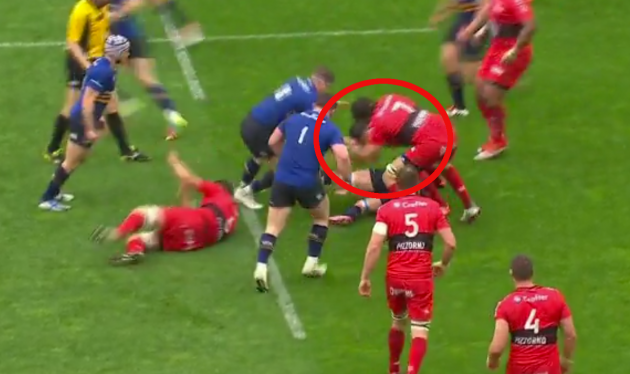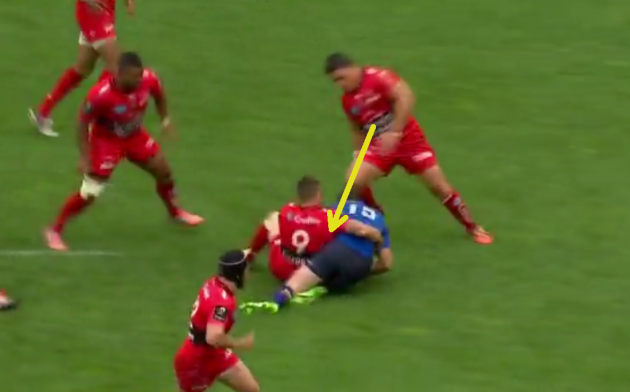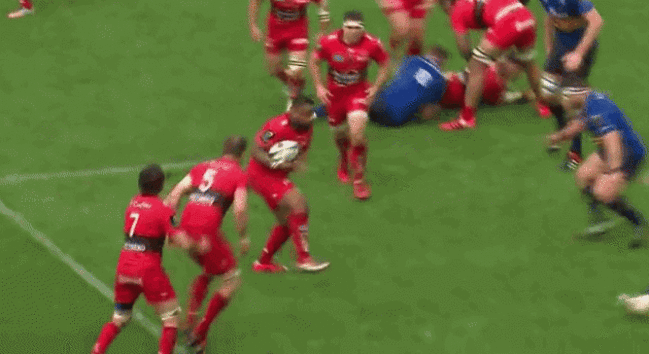SEAN O’BRIEN CAN always be relied upon to provide his honest opinion on all matters rugby and he must be respected for that, whether you agree with his thoughts or not.
In an era when many players and coaches do their best to say nothing at all, O’Brien is often a breath of fresh air.
So it proved again yesterday when the Leinster openside told us Toulon’s Steffon Armitage had been “completely illegal” at the breakdown in Sunday’s Champions Cup semi-final in Marseille.
O’Brien also stated that referee Wayne Barnes is someone “you can’t say anything to,” before underlining the difficulty match officials face and the need for Leinster to take breakdown matters into their own hands as much as possible.
Watching the game live in Marseille, we certainly felt that some of the decisions around the breakdown were dubious or borderline, so in light of O’Brien’s comments we’ve taken a closer look at each turnover in Sunday’s game.
What’s done is done, the result is obviously decided, but it’s always interesting to examine these high-level fixtures to learn exactly what’s going on at the breakdown. What are referees allowing and what are they struggling to pick up on?
Armitage’s attack
Despite not appearing off the bench until 36 minutes into the game, Armitage won three turnovers at the breakdown for Toulon, though the additional 20 minutes or so of extra time allowed him plenty of scope to wreak his havoc.
For the purposes of this article, we’re going to use the term ‘turnover’ as a signifier of either a clean steal of the ball post-tackle or a penalty won when the opposition ball carrier fails to release the ball under turnover pressure.
One
Armitage’s first turnover came just 1 minute and 19 seconds after he had stepped onto the pitch and gave Leinster realistic grounds for unhappiness.
We see the turnover penalty above, as Armitage gets a hit in on O’Brien and then clamps onto the ball as soon as the Leinster flanker has fallen to the ground.
The problem for Leinster here is that Armitage fails to release O’Brien after completing the tackle and before targeting the ball, while it’s also arguable whether or not Armitage is really in control of his own bodyweight.
The applicable law here is 15.6 (d), below, which is sometimes referred to as the ‘daylight law’.
Essentially it means any defender who brings the ball carrier to ground must release the tackled player before looking to win the turnover, as well as coming through the ‘gate.’
For all intents and purposes, there is a need for Armitage to show a clear release here before targeting the ball and he doesn’t do so. Leinster have grounds to complain in this instance.
Two
Armitage’s second turnover came in the 50th minute of play at Stade Vélodrome and this one didn’t see Barnes go to the whistle.
Luke Fitzgerald is the ball carrier this time and adds in a little commando roll on the ground in his efforts to ensure that Armitage can’t cleanly target the ball, but the Englishman still manages to sniff it out.
Is there a clear release this time between Armitage helping to bring the carrier to ground and playing the ball?
In the admittedly blurry frozen frame above, we can make out Armitage as having released Fitzgerald, although it would be extremely easy to argue that the Toulon man is not in control of his bodyweight already at this stage.
That impression is strengthened when we see Armitage’s forearms helping to support his bodyweight over the ball, as in the two different angles below.
As you’re probably aware, players competing for the ball have to support their own bodyweight without using their hands, knees, elbows, forearms, heads, or any part of their body aside from their feet.
Law 15.6 (a) is the relevant one here:
As Armitage uses his forearms to support himself over the ball, however briefly, he is off his feet and therefore not entitled to compete for the pill.
Before we go any further, it’s worth reminding ourselves of the sheer difficulty for the referee in this instance, with so much going on around him and the match moving at along at pace.
When we have the luxury of freezing frames, rewinding and rewatching, it’s straightforward to pick up on these breakdown offences. When the game is thundering along, it’s really very difficult.
Less than a second after Armitage’s forearms are supporting him, Barnes has been presented with the below ‘picture,’ one which paints the Toulon back row as on his feet and legally competing for the ball.
Players competing for turnovers are fully aware that rucking players will be arriving to hit them within split seconds, and like Armitage here they know they can go off balance beyond the ball and be driven back into a good position by the attacking ruckers.
It’s a problem for the game that referees are certainly doing their best to eradicate, but it can be difficult to spot them all. We should strive for our match officials to be 100% accurate of course, and the game is also about the contest, so over-punishing defenders competing for turnovers is not ideal either.
Back to the matter at hand, Leinster again have grounds to complain about Armitage’s steal.
Three
In the second minute of the first period of extra time, Armitage pounced for turnover number three.
This effort from Armitage is very difficult to argue with, as he hunts back around and through the ‘gate’ to clamp over the ball after Rob Kearney is tackled.
The pictures are good from Armitage throughout and he appears to be in control of his bodyweight without resting his hands on the ground or kneeling on the tackled player or tackler.
O’Brien said yesterday that Leinster needed to be better with their clear-outs against Toulon and that certainly applies in this case. The openside admitted that he had missed a barrel on Armitage at one stage, and this is it.
O’Brien and his teammates needed to be on the scene quicker here, and the same could be argued about the two previous turnovers we’ve looked at. Simply put – take the decision out of the referee’s hands by being there early and getting in low and aggressively.
Armitage beats O’Brien on this occasion for a high-quality turnover of possession.
What about SOB?
So it appears that O’Brien suggestion that Armitage was “illegal” does have some foundation, but what about the Tullow Tank himself? Were his breakdown efforts within the laws of the game?
The underlying issue here is that it’s not just Armitage who is pushing the boundaries with his skill and courage around the breakdown. Players across the world are often not supporting their bodyweight when jackaling, or often not releasing the tackled player.
O’Brien himself is no saint in terms of turnovers that are legal to the strictest letter of the law, nor are many of his Leinster and Ireland teammates. Let’s take a look at the three turnovers he affected in this particular game to see if he was ever “illegal.”
One
O’Brien’s first turnover of the game came in the 17th minute after Leigh Halfpenny carried the ball and was tackled by Ian Madigan.
As we can see above and again below, O’Brien assists in the tackle on Halfpenny.
That means O’Brien needs to show Barnes a clear release before targeting the ball, as well as staying on his feet, and he achieves that as we can see in the two freeze frames below.
It’s a nice clean view for Barnes and he’s entirely happy with O’Brien’s efforts in jackaling over the ball before Toulon’s supporting players arrive in to attempt the clear-out. O’Brien holds firmly onto the ball and Leinster get a penalty that’s hard to argue with.
Two
The Carlow man’s next turnover comes in the 54th minute, although the term ‘turnover’ is perhaps not ideal in this instance as Toulon came away with a feed into the scrum.
As we see above, O’Brien manages to get his hands on the ball after the tackle on Armitage, but Barnes awards the scrum to Toulon.
“There’s lots of bodies,” says Barnes. “Yes, you [O'Brien] got the ball up, you’ve got the ball up, but then your own man’s gone straight on top of you. Scrum, team going forward [Toulon].”
O’Brien is involved in the tackle on Armitage, but the main issue here is that the Leinster openside uses his hands to support himself as he subsequently targets the ball.
Above, we can see that O’Brien’s right arm is on the ground, as is his right knee. He’s not ‘on his feet,’ according to the laws of the game.
Then below, we can see that his left arm is on the ground at the exact same moment as his right arm, even if both his feet are now planted on the ground. It could also be argued that O’Brien is leaning his right knee into Armitage, therefore providing more support.
Either way, these frozen frames are not good pictures, but as with the second Armitage turnover we looked at, the image has changed within a split second as Toulon’s rucking players arrive.
O’Brien looks in a good position above, but that’s only on account of initially ‘illegal’ actions that allowed him to get driven back upright and with his hands now clasping the ball.
Three
O’Brien’s final turnover came just before half time in extra time, although it’s one he may wish he’d never made, with Bryan Habana intercepting a pass as Leinster looked to attack a disjointed defence directly after the steal.
This one is borderline and the fact that we have a poor camera angle on it makes it all the harder to analyse accurately. That said, we at The42 are fans of strict refereeing against the jackal and for us, O’Brien isn’t in control of his bodyweight in this instance.
As we can see below, O’Brien is not involved in the tackle and is on his feet coming through the ‘gate,’ and therefore entitled to target the ball as a ruck has not yet formed.
Again, we reiterate that the angle is not ideal here and it must be pointed out that Barnes is in the best position he could be in to judge whether O’Brien is really ‘on his feet’ in going for the ball.
However, the below picture doesn’t look great, with O’Brien having stretched himself out to reach the ball.
O’Brien’s right foot [red circle] is off the ground, while his right knee [yellow] appears to be heavily resting on the Alexandre Menini, the tackled player. It really doesn’t look good at all, but Barnes is happy enough to allow it and O’Brien wins the ball for Leinster.
Honours even
It was useful that O’Brien and Armitage both won three turnovers each in this game, hardly surprising given their ability at the breakdown and their position of openside flanker.
Our reading of the turnovers is that – by the letter of the law – both players had one clearly legitimate turnover while their other two efforts featured actions that go against the laws of the game.
For O’Brien to suggest that Armitage was “completely illegal” is probably fair to a degree, but that same accusation can be levelled against the Leinster man in this game and probably others.
It’s such a hugely complex area of the sport and as we’ve already mentioned it’s an exceptional difficult area to referee with so much going on.
The match officials are also attempting to track the offside line, watch for attacking ruck offences [players off their feet, etc.] and generally remaining aware of other aspects of the game.
The fact that lots of jackals are not playing by the laws of the game makes them extremely effective at stealing possession. Their oftentimes illegal actions make them incredibly difficult to shift away from the ball and that has partly been responsible for dangerous rucking from the ball carrier’s supporting players.
We’re increasingly seeing rucking players launch themselves off their feet and driving shoulders into the jackal’s back or neck, while the croc roll also has its critics. Both of these developments have come about partly because jackals are so effective.
The other turnovers
O’Brien and Armitage weren’t the only men to get in on the turnover action on Sunday, and since we’ve been looking at their involvements it’s worthwhile examining the other incidents in this domain.
They simply serve to underline that the breakdown is a minefield at present and that the jackal places great demands on rugby’s referees. Chris Masoe managed two turnovers in this game, while also being penalised for attempting another.
One
The Toulon number eight gave up the first points of the game with his failed turnover attempt, as Barnes had no hesitation in whistling.
Masoe’s problem here is that he uses at least one hand to support himself initially, as highlighted below.
Unlike O’Brien later in the game, Masoe is penalised for that action, Barnes simply using his own hand signals to indicate that the Toulon back row had his hands on the ground and instead needed to stay up on his feet.
Toulon could point to inconsistency in refereeing given that O’Brien and Armitage both got away with similar offences later in the game.
Two
Masoe’s first successful turnover brought a penalty for Toulon in the 35th minute of play.
This turnover comes with the major aid of the superb Juan Martín Fernandez Lobbe, and again the angles on it are not ideal for us. That said, it does appear that both players do initially get release after bringing the ball carrier [Jordi Murphy] to deck.
The difficulty is that we can’t get a view of Masoe’s arms thereafter. Is he supporting himself with his hands, forearms or elbows? Lobbe binds onto Masoe, so if the latter is not ‘on his feet’ then neither of them is entitled to play the ball.
Barnes is in a good position once again and decides that Toulon’s back row duo are making a legit turnover, so he penalises Leinster for holding on.
Three
Masoe’s third turnover involvement provided Toulon with the opportunity to score three points just before Habana’s try.
The actual jackaling movement itself is clean and there are no signs of Masoe not being on his feet here, although the fussiest of referees could potentially penalise the number eight for not coming through the gate.
However, for us it’s a fair turnover and once again points to Leinster’s lack of urgency at key times. Masoe has too much time to get over Rob Kearney and pilfer the ball, O’Brien and Jamie Heaslip arriving in too late to redeem the situation.
Church law
There were two other turnovers in this game, coming though Leinster props Marty Moore in the 61st minute and then Cian Healy in the 66th minute.
Above is Healy’s, below is Moore’s.
We’ll leave it up to you to analyse these two, so let us know what you think in the comments section. Is Healy legal in his actions here? Is this a fair turnover or would you have penalised the prop in this instance?
What about Moore? Is he involved in a tackle assist? Is he supporting his bodyweight fairly? Let us know what you see in these examples.
This article was updated at 11.05 to include the previously missing Marty Moore turnover.

